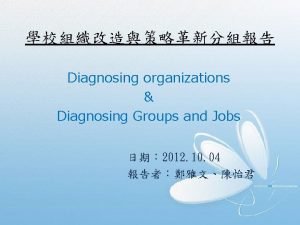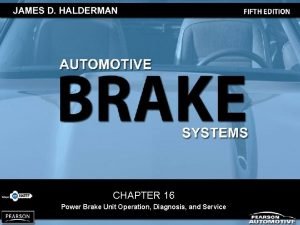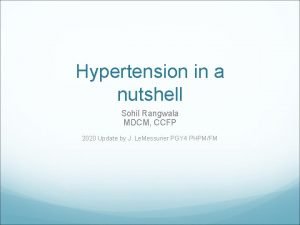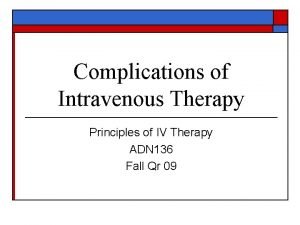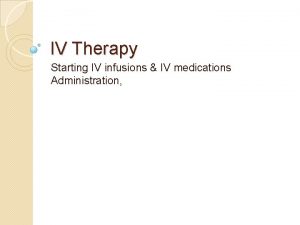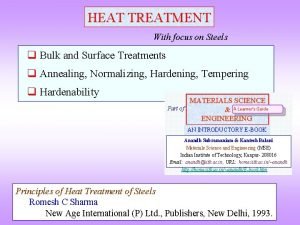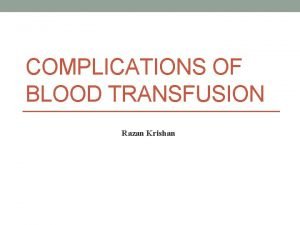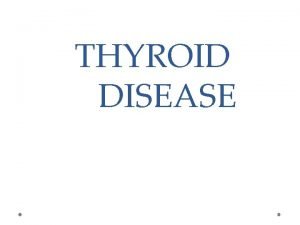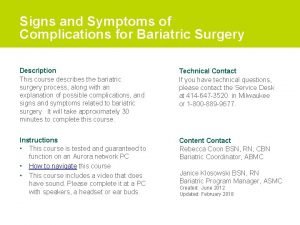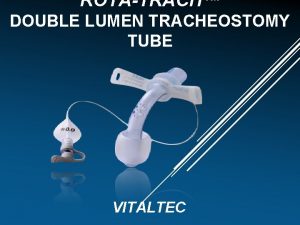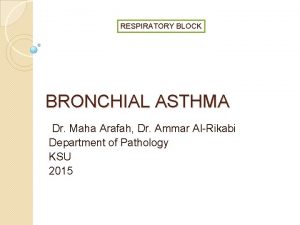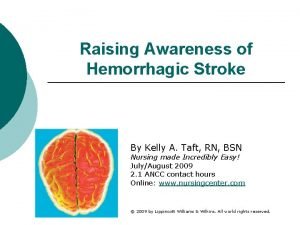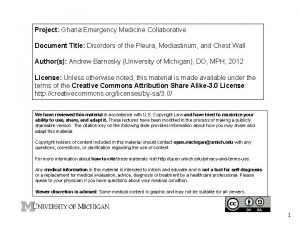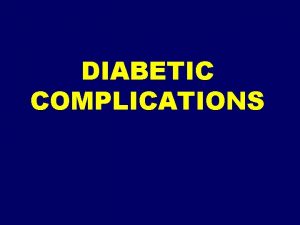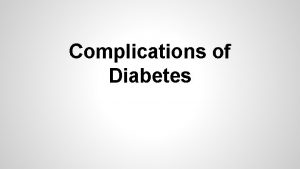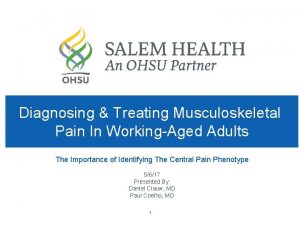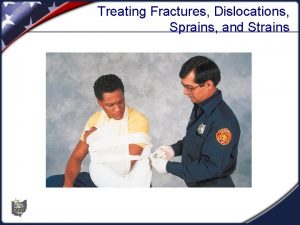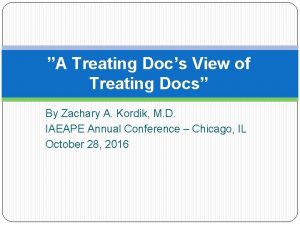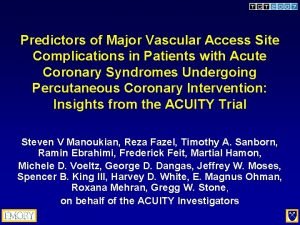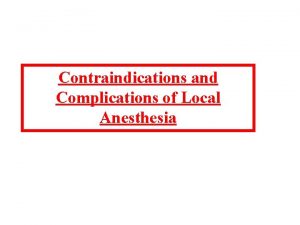Diagnosing and Treating Access Site Complications Michael J
































- Slides: 32

Diagnosing and Treating Access Site Complications Michael J. Singh, MD FACS RPVI UPMC Heart and Vascular Institute Co-director, UPMC Aortic Center February 2018

Michael Singh, MD FACS RPVI I have no disclosures and no relevant financial relationships related to this presentation.

Case example • 81 year old sedentary obese female • Nov 2017 coronary angio, PTCA via left CFA access • 6 Fr angioseal

Case example • December 2017 left groin pain – CTA 4 cm left CFA pseudoaneurysm • Successful thrombin injection • Jan 2018 gram (-) UTI

Case example • Feb 2018 admitted WBC 33, 000, left leg edema • Duplex scan left femoral vein DVT, AVF present • CTA showed left CFA mycotic thrombosed pseudoaneurysm

Case example • Jan 2018 left CFA ligation, repair of AVF, debridement and vac • February 2018 left above knee amputation

Significance of Access Site Complications • not infrequent and in many cases can be predicted • adverse events are directly associated with an increased M&M • common source of medical legal liability following interventions • timely diagnosis and management is essential

Access Site Complications “Alternative Facts or Truth? ” Increasing frequency? 1) more interventionists 2) expanding array of endovascular techniques 3) larger access, redo access 4) aging population 5) unfavorable anatomy 6) closure devices: • ISAR-CLOSURE study* • diagnostic: vasc closure 6. 9% v. manual 7. 9%* • Refuted NCDR Cath. PCI registry • manual 2. 8% v. 2. 1% closure device** * Schulz-Schupke S. JAMA 2014 ** Marso SP JAMA 2010 8

Closure Devices: Confounding Benefits • • Shorter time to hemostasis Quicker ambulation and discharge Patient satisfaction and comfort Perceived advantages of vessel closure (VCD) appear to support their continued utilization, but VCD… Ø fail to decrease overall complication rates; 1% diagnostic and 1 -6% for interventions Ø associated with device specific complications

• • • Biancari 2010 31 prospective studies, 7, 528 patients Randomized to VCD or compression

Complication rates: Meta-analysis of randomized trials on efficacy of VCD Ø Similar rates bleeding, transfusion, hematoma, false aneurysm Ø VCD- higher rates arterial ischemic complications, infection, need for surgical repair Biancari Am Heart J 2010

Access Site Complications- Facts Ø Diagnostic procedures 0. 5 -1. 8% Ø Interventions 1. 5 -9. 0% Ø All cause mortality 0. 8 -7. 5% • • • Femoral hematoma Retroper hematoma False aneurysm AV fistula Arterial occlusion Infection 1 -7. 7% 0. 7 -2. 5% 0. 5 -1. 7% 1. 5 % <1% Schulz-Schupke S. JAMA 2014 Marso SP JAMA 2010 Arora N Am Heart J 2007 12

• Femoral Access Site Complications: Contributing Factors Patient related: – – – – • Older age Female gender Small access vessel Low BMI or obesity PAD (CFA occlusive disease) Scar tissue at access site Diabetes, chronic kidney disease Procedure related: – high & low puncture groin • • – – independent predictor (OR, 28. 7; P<. 0001)* accounts for 71%* lateral wall laceration large caliber sheaths prior procedures GPIIB/IIIA infusion & lytic cases 13 *Sherev DA Catheter Cardio Interv 2005

Access Site Complications • Early diagnosis: – Peripheral vascular exam: pre & post procedure – Assess distal perfusion (pulses or ABI) – Serial access site exams post intervention • Adverse event management: – Compression – Endovascular options • balloon, stent, embolize, athrectomy, etc. – Open surgical repair • often the best choice in some situations

Access Site Complications • Infection • Bleeding – Hematoma, retroperitoneal bleeding, false aneurysm – Device or operator failure? – Anticoagulation? • Vessel occlusion – Direct mechanical- foot plates, plaque disruption, intimal dissection, thrombus formation – Embolization- plugs, plaque or thrombus

Access Site Infection • Relatively uncommon (<0. 25%) – despite placement of foreign body in access site • Practice good sterile technique – reprep access site before insertion of VCD • Consider prophylactic antibiotics • Major problem- treat aggressively – exploration, debridement and reconstruction

Femoral Access & VCD with Necrotizing Fasciitis

Femoral Hematoma • • Trivial or potentially life threatening Symptoms vary: • • • Ecchymosis early with progressive extension Risks: • • • mild to severe groin pain, access site swelling, skin necrosis low access, lateral wall laceration, large sheaths, failed closure, anticoagulation Ultrasound- quick and cost effective, assess for false aneurysm CTS- rule out retroperitoneal hemorrhage 18

Femoral Hematoma Management: • Manual compression, bed rest, correct coags, resuscitate, serial Hct and observation • Watch for delayed hemorrhage • Majority resolve without intervention- inform patient of prolonged bruising 19

Femoral Hematoma Indications for Surgical Repair • • • Severe pain Expanding hematoma Skin compromise Compression CFV (DVT risk) Femoral nerve compression Recurrent bleed – wound complication rate >25% 20

Arterial Repair and Evacuation Extensive Hematoma 21

Retroperitoneal Hematoma • Uncommon but morbid complication • High puncture above inguinal ligament • Risks- obese, women, post procedure anticoagulation, emergent procedure • Retroperitoneum- vast space, holds 2. 5 liters of blood 22

Retroperitoneal Hematoma- Diagnosis • Early recognition- essential • Abdominal pain & flank fullness • benign access site • Hypotension, tachycardia • Nerve compression- thigh pain, quadriceps weakness • Diagnosis- CTS, low threshold 23

Retroperitoneal Hematoma- Management • Individualized treatment plan • Correct coags, bed rest, serial Hct, transfuse if needed (4 PRBC) • Operate for nerve compression, hemodynamically unstable, expanding hematoma, compartment syndrome • Repair CFA injury and decompress retroperitoneum 24

Pseudoaneurysm • Failure of the arteriotomy site to close, contained bleed in soft tissue • Often difficult to pick-up • hematoma formation • low puncture: SFA or profunda • Risks- failed VCD, large sheaths, anticoagulation, poor compression technique • Symptomatic- painful pulsatile mass 25

Popovic 2008 11, 992 consecutive patient via femoral access over 4 years 76 PSA (0. 6%) univ analysis: interventional proc, rhythmologic procedures, left groin access were predictive factors PSA • compression successful 71% (P<0. 01) • • Popovic B, Int Jour Card 2008

Pseudoaneurysm- Management • Observation- spontaneous thrombosis of small (<2 cm) aneurysms in 2 -4 weeks • U/S guided compression- 70 -90% successful • • time consuming, painful, mean time 22 min (20 -120 min) • 30 -50% successful with anticoagulation Thrombin injection- >95% successful • off label use, risk DVT/PE if undetected AVF, arterial thrombosis • good for PSA narrow(<3 mm) necks, • not for broad necks or small native vessels (<4 mm) or large PSA (> 8 cm) • Open surgical repair- AVF, broad neck • Balloon occlusion, covered stent or coil embolization? 27

Acute Arterial Occlusion • Embolization – Plaque – Thrombus – Closure device foot plate

VCD Placed Intravascular collagen plug, foot plate, plaque

Prevention of Access Site Complications • Access: choose the correct site and location (femoral, radial, etc. ) – – – Fluoroscopy or U/S guided access Micro puncture access, single puncture anterior wall Observe guidewire advancement Routine femoral angio before upsizing Smallest sheath necessary • Anticoagulation strategy – Avoid use if high puncture • Proper patient and closure device selection

Conclusions • Access site complications occur infrequently and in many cases can be predicted • VCD generally demonstrate a good performance compared to manual compression • VCD are associated with an increased risk of infection, lower limb ischemia and need for surgical intervention • Be observant for procedure related access site complications, early diagnosis and intervention are necessary for favorable outcomes 31

Thank you Pittsburgh, PA
 Group level diagnostic model
Group level diagnostic model The first step in diagnosing a hydro-boost problem is
The first step in diagnosing a hydro-boost problem is Diagnosing hypertension
Diagnosing hypertension Sohil rangwala
Sohil rangwala Yodsawalai chodpathumwan
Yodsawalai chodpathumwan Diagnosing rheumatoid arthritis
Diagnosing rheumatoid arthritis Diagnosing your cultural intelligence
Diagnosing your cultural intelligence Phlebitis vs infiltration
Phlebitis vs infiltration Iv site pain and swelling
Iv site pain and swelling Chapter 24 lesson 2 preventing and treating stds
Chapter 24 lesson 2 preventing and treating stds Hot site cold site warm site disaster recovery
Hot site cold site warm site disaster recovery Tumor treating fields mechanism of action
Tumor treating fields mechanism of action Cognitive approach to treating depression
Cognitive approach to treating depression Ethical issues in treating lgbt patients
Ethical issues in treating lgbt patients Two process model of phobias evaluation
Two process model of phobias evaluation Tcf outcomes 1 6
Tcf outcomes 1 6 Wholesale hardening and tempering
Wholesale hardening and tempering Business ethics chapter 4
Business ethics chapter 4 Complications of blood transfusion
Complications of blood transfusion Blood transfusion complications
Blood transfusion complications Definition short story
Definition short story Elements of setting
Elements of setting Terminal access controller access-control system
Terminal access controller access-control system Terminal access controller access-control system
Terminal access controller access-control system Thyroid
Thyroid Eswl complications
Eswl complications Complications c section
Complications c section Sleeve gastrectomy complications
Sleeve gastrectomy complications Complications of shigellosis
Complications of shigellosis Double cannula tracheostomy tube
Double cannula tracheostomy tube Bronchial asthma
Bronchial asthma Cva complications
Cva complications Document
Document
